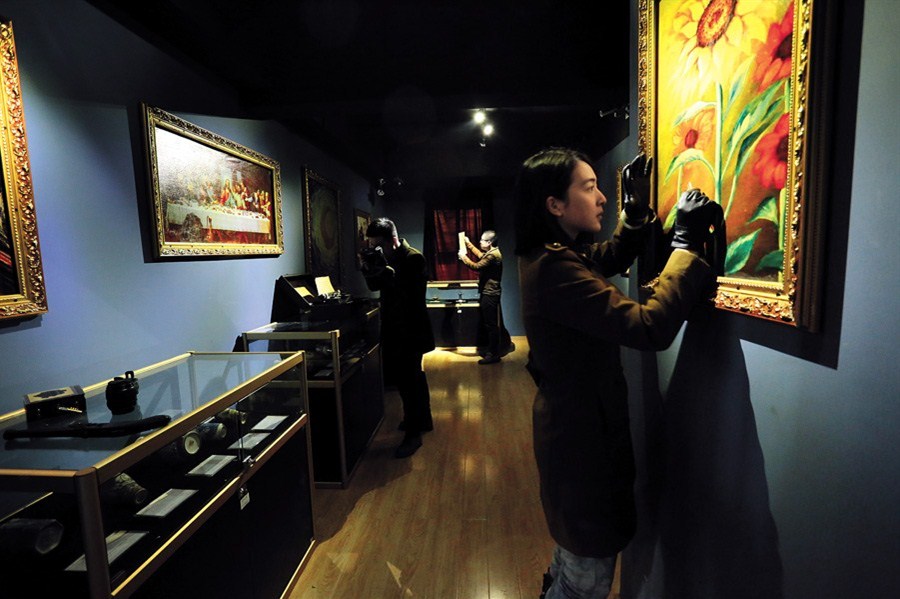BY: JENNY FORD
Tomorrow, I will be escaping through the tunnels of Casa Loma as a bootlegger. It will be my fourth escape game. I’ve been a Second World War spy, a pirate’s prisoner, and even a museum burglar. And, yes, I'm quite addicted.
Real life escape games emerged around 2012. The idea is you’re locked in a room (or series of rooms), solving puzzles with your friends as you try to escape. You take apart props, crack codes, and discover secret passages to get out of the room on time. Games have storylines—prison break, insane asylum, haunted house—that move forward as you progress through the game.
 |
| A prison-themed escape room in Montreal. Source. |
So, why is this in a museum blog? I’ve actually found many parallels between exhibition development and escape game development, especially when it comes to narrative experiences. I'd hazard they may not be so different, after all.
THE NARRATIVE MUSEUM
Over the last few years, museums have started to emphasize the role of narrative in exhibitions. As one blog outlines, narrativity plays a huge role in visitor learning, especially with information retention.
Humans are natural storytellers, and we love good dramas and good characters. Exhibitions that capitalize on these notions create emotional connections, which make the experience more engaging. Exhibitions are also easier to follow when they're designed after a storytelling arc.
 |
| A museum-themed escape game in Shanghai. Source. |
These are still concepts museums are perfecting and experimenting with, in some cases. And this is where the escape experience comes in.
THE ESCAPE NARRATIVE
I should preface all this by saying there are some terrible escape games out there… just like there are bad exhibitions. In fact, designing a good escape game is extremely difficult. A designer has to create nesting and escalating intellectual challenges that interlink, allowing players to both feel challenged and successful. All the while, an escape game is carrying on a storyline that reveals more and more information.
 |
| This game has been destroyed by an escape team! Source. |
Now, read those last two sentences and replace “escape game” with “exhibit” and “players” with “visitors”. Aren’t exhibits much the same, in this way? A good exhibit is not necessarily supposed to be “easy”—it should be intellectually stimulating, while feeling like you’ve made breakthroughs. Too basic or too complex and you lose people.
Good escape games also have the narrative concept down. They often follow story arcs, get people emotionally involved, and definitely get you into the “flow”, although you are always aware of the ticking clock so you escape in time!
A GOOD ESCAPE GAME
Adam Clare, a George Brown instructor, wrote the how-to book on escape games, outlining how they’re designed and what makes a good one. There are lots of exhibit connections to some of these fundamentals that museums can draw on:
- An enticing theme that’s carried through the whole experience
This almost goes beyond the big idea to the essence of a theme and how that theme feels as it's carried through every element of the experience. It's often a question of good 3D design.
- A narrative that engages players, where solving puzzles advances the storyline
While this is akin to a story arc, it perhaps makes us look at objects differently. Instead of each object being an illustration of the main story, they effectively move the story forward, sharing more events that enhance the narrative. - Rewarding ending
Escape games embody this concept in a rewarding ending puzzle. Can exhibits capture this idea too once visitor get to the end? A surprise information reveal or object? - Have surprises
There are always surprises in escape games—a secret room, a tunnel, lasers. Exhibitions don’t have to be predictable. Have surprises and moments that maybe not everyone will see, but when they do it’s incredibly rewarding. - Consider group size and timing
This is crucial for escape games. Too many players and people are standing around. Too few and they can’t solve the puzzles on time. But we only sometimes consider these notions in museum exhibitions. What’s the average group and how will that change how they interact with the space?
LET THE DEBATE BEGIN! SHARE YOUR THOUGHTS.


No comments:
Post a Comment
Note: only a member of this blog may post a comment.